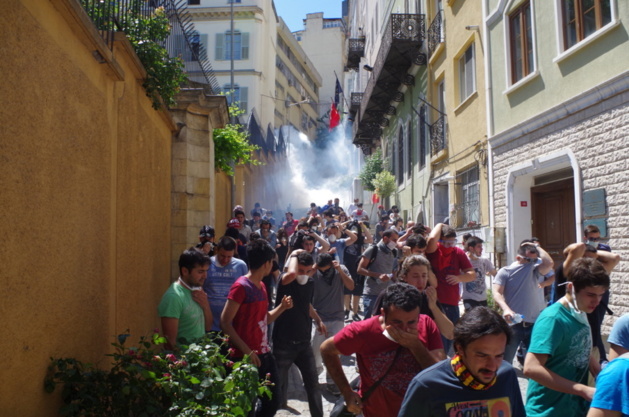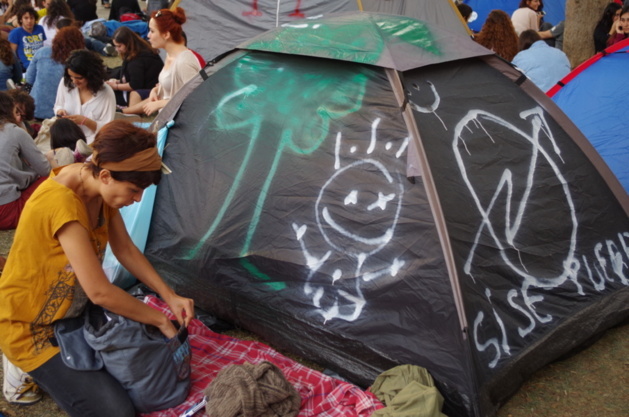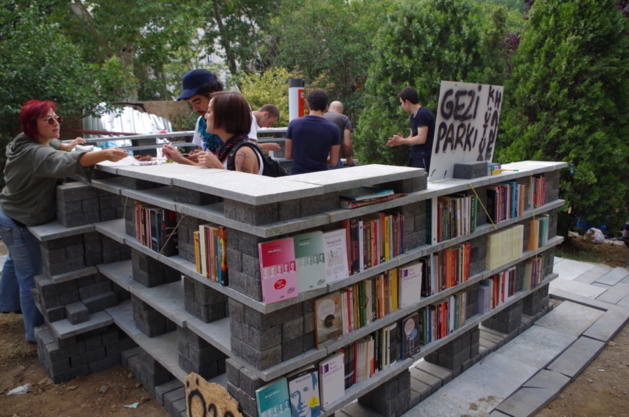
Demonstrators attempting to hide from tear gas ( via the street Istiklal) © Lou Bachelier-Degras
After a ten-years policy pursued by the Justice and Development Party (AKP) headed by Recep Tayyip Erdogan, Turkey regained a central place in the Middle East and is now setting an example for the people of Arab countries who rose up against their despots. However, Turkey may not be comparable to the majority of Arab countries, given that it has had a democratic political system with free and multiparty elections for 50 years. Turkey also benefits from a cultural diversity, about which it boasts internationally.
Moreover, per capita income has tripled in the last ten years, and Turkey has the second fastest growing economy in the world behind China's. How can we explain that this role model country of the Middle East is being crossed by a spontaneous and massive protest movement, never experienced before by the Atatürk Republic?
Moreover, per capita income has tripled in the last ten years, and Turkey has the second fastest growing economy in the world behind China's. How can we explain that this role model country of the Middle East is being crossed by a spontaneous and massive protest movement, never experienced before by the Atatürk Republic?
A TURKISH SPRING?
Even if he was reelected in 2011 with nearly 50% of the votes, Erdogan is crystallizing the bitterness of a part of the Turkish population. Erdogan launched a series of large-scale projects across the country in order to modernize it, in preparation for the 2023 centenary of the Republic. At the same time, his way of governing has become harsher and he does not allow any contradiction. 327 deputies in 550-seat Assembly belong to the AKP, which can therefore pass any legislation that it wants.
This is the way an urban development project has been decided in Istanbul. The former mayor of the city decided to raze a public park next to Taksim Square, which is one of Turkey’s largest, most crossed and most symbolic square. This park, filled with 700 trees, was designed in 1940 by the city planner Henri Prost. It is located on the area of a former Ottoman barrack site that was bulldozed. Erdogan's project aim at rebuilding these barracks and turning this site into a retail and cultural center. However, the pedestrian Istiklal Avenue, that is used every day by one million people and that comes out at Taskim Square, is already full of shopping centers and shops. Moreover, the North end of Taskim Square is closed off by the Atatürk Cultural Center, a modern opera and temple to a secular and Western culture, which was erected to the glory of the Republic built by Mustafa Kemal Atatürk, the first President of the country.
This is the way an urban development project has been decided in Istanbul. The former mayor of the city decided to raze a public park next to Taksim Square, which is one of Turkey’s largest, most crossed and most symbolic square. This park, filled with 700 trees, was designed in 1940 by the city planner Henri Prost. It is located on the area of a former Ottoman barrack site that was bulldozed. Erdogan's project aim at rebuilding these barracks and turning this site into a retail and cultural center. However, the pedestrian Istiklal Avenue, that is used every day by one million people and that comes out at Taskim Square, is already full of shopping centers and shops. Moreover, the North end of Taskim Square is closed off by the Atatürk Cultural Center, a modern opera and temple to a secular and Western culture, which was erected to the glory of the Republic built by Mustafa Kemal Atatürk, the first President of the country.
The events on 31st of May and 1st of June

Knowing that the destruction of the park was about to happen, environmental activists decided to peacefully occupy Gezi Park. One of them, Alkim, a student in communications, has been staying in the park since May 29. This student, who considers that the decision to cut down trees was illegal, remembers: "The atmosphere in the park was great and festive. There was music… We did not understand police violence…". At dawn on Friday May 31, the police, in charge of evacuating the park so that the work could begin, expelled the few occupiers of the park and used tear gas and water cannons to that end. The police burnt tents, musical instruments and other belongings that they found there.
Police violence against peaceful demonstrators was the last straw. Hundreds and then thousands of young people gathered towards Taksim Square, which was already occupied by the riot police. Around 3 pm, the park was occupied by the police but its limits were still widely accessible. Here and there, a few tear gas grenades exploded in the square.
The square, center of the bus network in Istanbul, and usually crossed by thousands of workers, students and tourists, was emptied in a few minutes and surrounded by tear gas.
From 4 pm, policemen, with the assistance of mobile water cannons, began to fire tear gas grenades in all directions to and around the square. The few pedestrians who were there could only take shelter in the shops located on the square which was saturated with gas. The few tourists who unfortunately happened to be passing by were running for the closest shops and hotels. They showed pain on their faces and hurried to lock the doors behind them. The young demonstrators wishing to fight with the police, or who simply refused to remain passive, were repulsed by water cannons on the Istiklal Avenue. However, while the square was emptied by the police, the Istiklal Avenue was filled up by protesters.
On the edge of Taksim Square, the clashes with the police continued all evening and part of the night. At 1 am, the Istiklal Avenue was empty and it was still impossible to breathe properly without wearing a scarf. On the orders of the President of the Republic M. Abdullah Gül, the police left Taksim Square in the afternoon, after a new morning of violent clashes.
Police violence against peaceful demonstrators was the last straw. Hundreds and then thousands of young people gathered towards Taksim Square, which was already occupied by the riot police. Around 3 pm, the park was occupied by the police but its limits were still widely accessible. Here and there, a few tear gas grenades exploded in the square.
The square, center of the bus network in Istanbul, and usually crossed by thousands of workers, students and tourists, was emptied in a few minutes and surrounded by tear gas.
From 4 pm, policemen, with the assistance of mobile water cannons, began to fire tear gas grenades in all directions to and around the square. The few pedestrians who were there could only take shelter in the shops located on the square which was saturated with gas. The few tourists who unfortunately happened to be passing by were running for the closest shops and hotels. They showed pain on their faces and hurried to lock the doors behind them. The young demonstrators wishing to fight with the police, or who simply refused to remain passive, were repulsed by water cannons on the Istiklal Avenue. However, while the square was emptied by the police, the Istiklal Avenue was filled up by protesters.
On the edge of Taksim Square, the clashes with the police continued all evening and part of the night. At 1 am, the Istiklal Avenue was empty and it was still impossible to breathe properly without wearing a scarf. On the orders of the President of the Republic M. Abdullah Gül, the police left Taksim Square in the afternoon, after a new morning of violent clashes.
THE GEZI'S CONSCIENCE?

Istanbul was the starting point of the protests that are now reaching the country's main cities, including Ankara, which is the political capital city of the country and is known for being conservative. According to the union of Turkish doctors, 4,355 people were injured and 3 persons were killed across the country within a week. According to the Turkish Ministry of the Interior, more than 90 demonstrations took place.
Since the police left Gezi Park on Saturday, the neighboring square and the park have turned into important forums and areas of libertarian release. On Saturday morning, the Istiklal Avenue looked more like Bagdad in 2003 than an equivalent of the Champs-Elysées Avenue. However, public degradations were still rather limited. The square and the park, located on top of a hill, were protected by barricades to prevent or slow down the return of the riot police officers, and looked therefore like a fortress.
All means of expression – such as street art, performances, meetings, tents set up by associations, free concerts, leafleting, building of a library using cobblestones… And spontaneous conversations in the park – were used. What really stand out is not only the violence of the clashes in the first days of the protests and in the following days in other Turkish cities, but also and mostly the sense of joyful freedom in Gezi Park. On Taksim Square, there are now only pedestrians and people of all ages and of every background from this more and more Western and European Turkey.
Since the police left Gezi Park on Saturday, the neighboring square and the park have turned into important forums and areas of libertarian release. On Saturday morning, the Istiklal Avenue looked more like Bagdad in 2003 than an equivalent of the Champs-Elysées Avenue. However, public degradations were still rather limited. The square and the park, located on top of a hill, were protected by barricades to prevent or slow down the return of the riot police officers, and looked therefore like a fortress.
All means of expression – such as street art, performances, meetings, tents set up by associations, free concerts, leafleting, building of a library using cobblestones… And spontaneous conversations in the park – were used. What really stand out is not only the violence of the clashes in the first days of the protests and in the following days in other Turkish cities, but also and mostly the sense of joyful freedom in Gezi Park. On Taksim Square, there are now only pedestrians and people of all ages and of every background from this more and more Western and European Turkey.
PEOPLE OF ALL AGES MARCHING FOR FREEDOM
A survey of demonstrators’ motives, conducted by Bilgi University professors, set forth the main reasons to hold demonstrations. 92% of the demonstrators indicated that they were willing to fight the Prime Minister's authoritarianism. At 84% in second place, those surveyed considered police violence and the silence of Turkish media on this violence as a reason to demonstrate. Finally, 56% were protesting against the park's destruction. On the 3,000 respondents, 70% did not identify with a political party, and 60% were below 30 years of age.
Even if the protests in Taksim and Besiktas (where are located the Prime Minister's office in Istanbul) are mainly filled with young people, older people living in several more or less conservative areas of Istanbul have shown solidarity with the demonstrators by banging pans for more than 15 minutes every night at 9 pm for a week.
"Freedom !" is the word which keeps on turning up when talking to the Turkish demonstrators in Gezi Park. Hilay, who is studying at the University of Galatasaray, considers that Erdogan pries into people's personal life by telling them how to live or by directly calling them into question. Demonstrators refer to the Prime Minister’s statements labeling every person drinking alcohol as "alcoholic", speeches about necessity to have 3 children, projects calling contraception and abortion into question, and a law that was very recently voted and that restricts the sale of alcohol.
According to Kadir, who is studying engineering, the most important thing is not one or another governing party, but the respect of all citizens and the need of recalling that a politician cannot do whatever he wants. He also pointed out that the strength of this movement consists in rallying, in unprecedented ways, former political opponents such as Kemalists and Kurds, and that freedom of expression is the most important thing. He recalled that Erdogan declared that he has nothing to ask to the Turkish people and that he will do whatever he wants. Kadir has been fighting against this idea for a week, at the expense of his studies. All of this is done for promoting dialogue within the Turkish society.
These thousands of young people who are distributing food and water to strangers in the park, instead of taking their end-of-year examinations, are denouncing the pressure exerted on their way of life as well as the lack of dialogue between civil society and the political power. Since the 1980 military coup, civil society and the cultural community have lost their meaning, given that coercive conditions hindering their rebirth are still prevailing (for example, a minimum of 12 people – versus 3 in France – is needed to set up an association).When walking through Gezi Park, which has been self-managed for a week and has become an utopic village between the trees, one sees several tents set up by associations and syndicates building that might be referred to as a Turkish "progressive camp".
Even if the protests can end at any time, Taksim Square and the park became a symbol for many Turks. According to Melda, another student, this movement was a trigger point: "I used to be afraid to go out and protest, and to be alone. Now I have to be here, I can't stay home while we are maybe having what is one of the few opportunities to change something!" The protest movement has brought to the young Turks a will to invest and also a hope for change – maybe the very best of the protest.
Even if the protests in Taksim and Besiktas (where are located the Prime Minister's office in Istanbul) are mainly filled with young people, older people living in several more or less conservative areas of Istanbul have shown solidarity with the demonstrators by banging pans for more than 15 minutes every night at 9 pm for a week.
"Freedom !" is the word which keeps on turning up when talking to the Turkish demonstrators in Gezi Park. Hilay, who is studying at the University of Galatasaray, considers that Erdogan pries into people's personal life by telling them how to live or by directly calling them into question. Demonstrators refer to the Prime Minister’s statements labeling every person drinking alcohol as "alcoholic", speeches about necessity to have 3 children, projects calling contraception and abortion into question, and a law that was very recently voted and that restricts the sale of alcohol.
According to Kadir, who is studying engineering, the most important thing is not one or another governing party, but the respect of all citizens and the need of recalling that a politician cannot do whatever he wants. He also pointed out that the strength of this movement consists in rallying, in unprecedented ways, former political opponents such as Kemalists and Kurds, and that freedom of expression is the most important thing. He recalled that Erdogan declared that he has nothing to ask to the Turkish people and that he will do whatever he wants. Kadir has been fighting against this idea for a week, at the expense of his studies. All of this is done for promoting dialogue within the Turkish society.
These thousands of young people who are distributing food and water to strangers in the park, instead of taking their end-of-year examinations, are denouncing the pressure exerted on their way of life as well as the lack of dialogue between civil society and the political power. Since the 1980 military coup, civil society and the cultural community have lost their meaning, given that coercive conditions hindering their rebirth are still prevailing (for example, a minimum of 12 people – versus 3 in France – is needed to set up an association).When walking through Gezi Park, which has been self-managed for a week and has become an utopic village between the trees, one sees several tents set up by associations and syndicates building that might be referred to as a Turkish "progressive camp".
Even if the protests can end at any time, Taksim Square and the park became a symbol for many Turks. According to Melda, another student, this movement was a trigger point: "I used to be afraid to go out and protest, and to be alone. Now I have to be here, I can't stay home while we are maybe having what is one of the few opportunities to change something!" The protest movement has brought to the young Turks a will to invest and also a hope for change – maybe the very best of the protest.



























